- Joined
- Nov 23, 2014
- Messages
- 2,632
Spring time in Michigan so time to get back into the shop to reproduce more Erector set parts. The part here is Erector part# CQ slotted coupling. It’s a 5/16” diameter piece of brass 5/8” long. It has 6-32 and 8-32 tapped holes and a slot for attaching a flat strip to the cylindrical bushing. I’ll start with the obligatory Erector history lesson . . .
The CQ was introduced in 1924 and was included in just the largest set sold (No. 10). Its function was to connect a 5/32” diameter rod to a flat strip. Wow, exciting . . . I looked through the No. 10 manual from 1924 and found 7 or 8 models that used the part. So, not a widely used part. However, collectors of Erector sets strive to complete their sets with complete inventories of all the parts as it left the factory, so small as the market may be, there actually is one.
The CQ’s most prominent use was in the classic Hudson locomotive model. Two were used in the locomotive model (one per side). Function was to connect the crosshead to the steam engine push rod. A manual page shows the use.
OK, on to my way of making them. Sketch of the part is in the photos. I make use of hardened steel drill bushings for locating cross and axial holes. Same process here for the cross holes; started with a piece of 1” drill rod chucked up, center drilled and drilled with a 5/16” bit for slipping over a brass blank.
Next step was setting the drill rod in a 5-C collet and locking it in a square collet block. The drill rod would eventually become a hardened drill bushing. I paint markered the width of the collet block on the block for reference; keeps me from measuring the width every time I use it as most of my work is at the center line of the block.
Found the end of the drill rod with an electronic edge finder, then spot drilled and drilled through holes for the 6-32 and 8-32 tap drills. I turned the collet block 90 deg. and repeated all of the drilling as it gives me 2 sets of holes to use in case the bushing starts to wear.
Back to the lathe for parting to slightly over the 5/8” overall length, then faced to 5/8” overall length. Then over to the weld bench for heat treating with an oxyacetylene torch. I left the bushing hard as I have plenty of 6-32 and 8-32 tap drills. Would rather replace/sharpen them than have to make another drill bushing.
On to making parts. Loaded a length of 5/16” diameter brass in a collet and drilled the 11/64” axial hole. I have it pictured in another thread, but use a drill bushing to locate the central hole. The hardened drill bushing slips over the 5/16” rod and has a centered 11/64” hole which holds the drill bit in the tail stock on center. Saves spotting/center drilling, then changing to an 11/64” drill bit.
Next step is to load the 2nd drill bushing over the brass rod and flush it up at the end. I use a parting tool to back up the bushing so it doesn’t slide back/forth on the brass rod. Then drill the 8-32 tap drill hole with a hand drill. Pin the bushing to the brass with a drill bit shank and drill the 6-32 tap drill hole. Remove the bushing and power tap the 6-32 and 8-32 holes with a pair of hand drills.
The drill bushing is 5/8” long, same length as the CQ. Using the parting tool to back up the drill bushing also positions the tool properly for parting to the correct length.
OK, on to the fixture to hold the brass round on the mill for cutting the slot with a slitting saw. The holding fixture was made from a block of aluminum. There’s a flat bottomed 5/16” diameter hole for holding the brass rod. Maybe overkill on my part, but I also drilled a 5/32” through hole for a piece of rod stock which drops into the center of the CQ. Drilled & tapped a 6-32 hole for a screw to lock the 5/32” rod in place. Also drilled a clearance hole for a 6-32 set screw.
In use, a brass blank is set in the block and a 6-32 screw run into the tapped hole in the CQ. This orients the part vertically so the slot is normal to the tapped holes. Also holds the blank in place for slitting.
Set up on the mill was pretty simple, especially with a DRO. Touched the slitting saw to the top of the brass blank and zero’d the readout. Then moved to the bottom of the blank and hit the half-Z axis button. Moved to center and locked the knee. Touched the end of the brass with the saw blade and zero’d X. I crank the table toward me, load a part, tighten the set screw and crank the Y back into the slitting saw blade to cut the slot.
Took a few hours to make the fixturing and bushing, but they really pay off when it comes time to making parts. I crank out at least 15 per hour at a sales price of $7 each. Thanks for looking!
Bruce
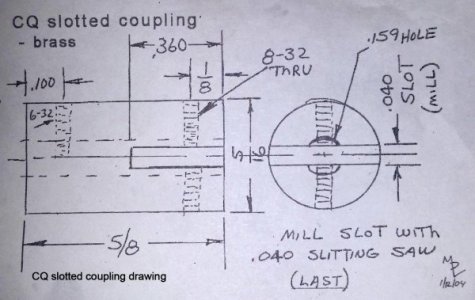
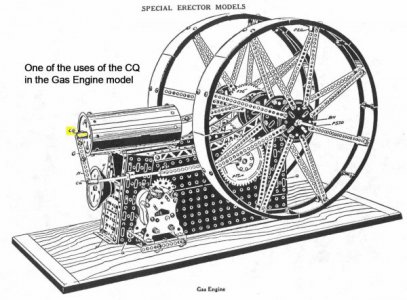
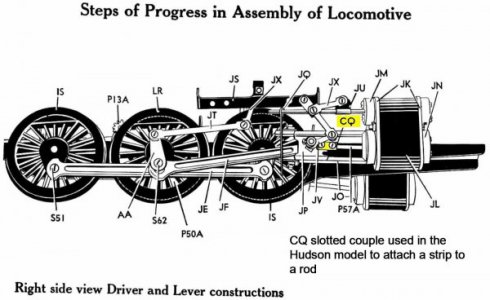
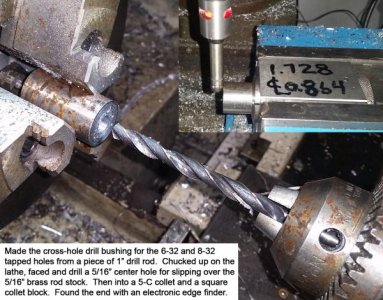
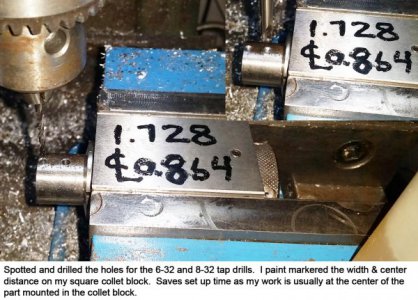
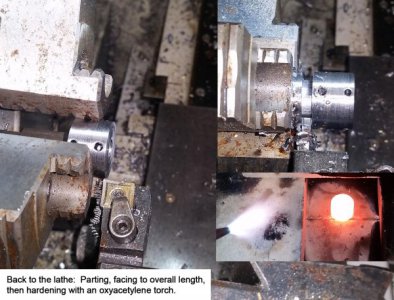
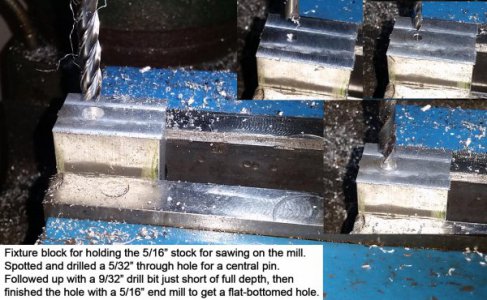
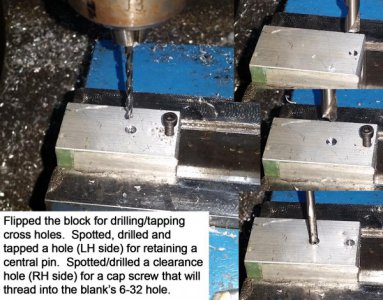
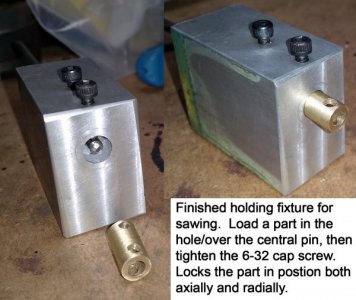
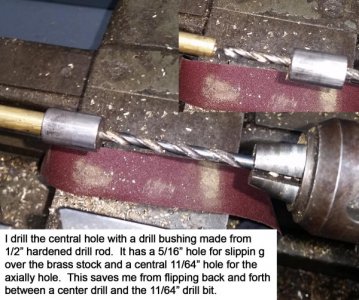
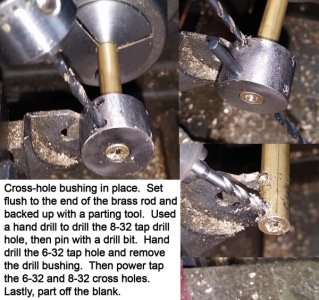
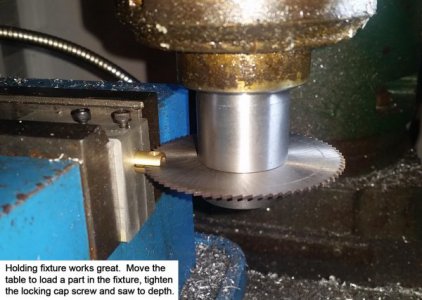
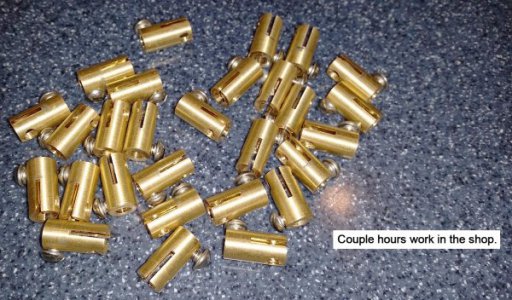
The CQ was introduced in 1924 and was included in just the largest set sold (No. 10). Its function was to connect a 5/32” diameter rod to a flat strip. Wow, exciting . . . I looked through the No. 10 manual from 1924 and found 7 or 8 models that used the part. So, not a widely used part. However, collectors of Erector sets strive to complete their sets with complete inventories of all the parts as it left the factory, so small as the market may be, there actually is one.
The CQ’s most prominent use was in the classic Hudson locomotive model. Two were used in the locomotive model (one per side). Function was to connect the crosshead to the steam engine push rod. A manual page shows the use.
OK, on to my way of making them. Sketch of the part is in the photos. I make use of hardened steel drill bushings for locating cross and axial holes. Same process here for the cross holes; started with a piece of 1” drill rod chucked up, center drilled and drilled with a 5/16” bit for slipping over a brass blank.
Next step was setting the drill rod in a 5-C collet and locking it in a square collet block. The drill rod would eventually become a hardened drill bushing. I paint markered the width of the collet block on the block for reference; keeps me from measuring the width every time I use it as most of my work is at the center line of the block.
Found the end of the drill rod with an electronic edge finder, then spot drilled and drilled through holes for the 6-32 and 8-32 tap drills. I turned the collet block 90 deg. and repeated all of the drilling as it gives me 2 sets of holes to use in case the bushing starts to wear.
Back to the lathe for parting to slightly over the 5/8” overall length, then faced to 5/8” overall length. Then over to the weld bench for heat treating with an oxyacetylene torch. I left the bushing hard as I have plenty of 6-32 and 8-32 tap drills. Would rather replace/sharpen them than have to make another drill bushing.
On to making parts. Loaded a length of 5/16” diameter brass in a collet and drilled the 11/64” axial hole. I have it pictured in another thread, but use a drill bushing to locate the central hole. The hardened drill bushing slips over the 5/16” rod and has a centered 11/64” hole which holds the drill bit in the tail stock on center. Saves spotting/center drilling, then changing to an 11/64” drill bit.
Next step is to load the 2nd drill bushing over the brass rod and flush it up at the end. I use a parting tool to back up the bushing so it doesn’t slide back/forth on the brass rod. Then drill the 8-32 tap drill hole with a hand drill. Pin the bushing to the brass with a drill bit shank and drill the 6-32 tap drill hole. Remove the bushing and power tap the 6-32 and 8-32 holes with a pair of hand drills.
The drill bushing is 5/8” long, same length as the CQ. Using the parting tool to back up the drill bushing also positions the tool properly for parting to the correct length.
OK, on to the fixture to hold the brass round on the mill for cutting the slot with a slitting saw. The holding fixture was made from a block of aluminum. There’s a flat bottomed 5/16” diameter hole for holding the brass rod. Maybe overkill on my part, but I also drilled a 5/32” through hole for a piece of rod stock which drops into the center of the CQ. Drilled & tapped a 6-32 hole for a screw to lock the 5/32” rod in place. Also drilled a clearance hole for a 6-32 set screw.
In use, a brass blank is set in the block and a 6-32 screw run into the tapped hole in the CQ. This orients the part vertically so the slot is normal to the tapped holes. Also holds the blank in place for slitting.
Set up on the mill was pretty simple, especially with a DRO. Touched the slitting saw to the top of the brass blank and zero’d the readout. Then moved to the bottom of the blank and hit the half-Z axis button. Moved to center and locked the knee. Touched the end of the brass with the saw blade and zero’d X. I crank the table toward me, load a part, tighten the set screw and crank the Y back into the slitting saw blade to cut the slot.
Took a few hours to make the fixturing and bushing, but they really pay off when it comes time to making parts. I crank out at least 15 per hour at a sales price of $7 each. Thanks for looking!
Bruce













